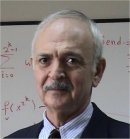|
Keynote
Lecture
High Dimensional Model Representation (HDMR) and
Enhanced Multivariance Product Representation (EMPR) as
Small Scale Multivariate Decomposition Methods

Professor Metin Demiralp
Informatics Institute
Istanbul Technical University
TURKEY
E-mail:
metin.demiralp@be.itu.edu.tr
Abstract: The method of finite elements is quite
frequently used in the solution of boundary value
problems modelled as either ordinary differential
equations (ODEs) or partial differential equations
(PDEs). It is based on basically weak derivative and
Sobolev space concepts. An appropriate bilinear form is
constructed from the given equations and accompanying
boundary conditions by using these concepts. Then the
unknown function is approximately expressed in terms of
appropriately defined spline functions over certain
convenient subregions of the problem geometry. The
linear combination constructed towards this goal
contains certain undetermined constants which appear in
an algebraic equation, that is linear for the linear
ODEs or PDEs, together with linear boundary impositions
like Dirichlet or Neumann conditions. The important
issue in this approach is the construction of the spline
basis set, which is realized in such a way that the
resulting algebraic equations possess rather simple
structure to be solved for the unknowns. Finite elements
can be used for almost anything either derived from ODEs
or PDEs, or directly from a function in certain ways
although the most desired cases are the differential
equations.
Recent developments, especially in last decade, made it
possible to decompose a multivariate function or its
image under certain appropriate operators to some
components which are ordered in ascending multivariance.
This approach which was originally proposed by Sobol has
been extended to more general representations after the
studies by Rabitz group in Princeton and Demiralp group
in ?Istanbul, even though the number of the scientists
concerning with the issues have been increased recently.
The method was named High Dimensional Model
Representation (HDMR). There are now many different
varieties of HDMR in accordance with the certain
particularities of the target function, especially after
many works in the Group for Science and Methods of
Computing (GfSaMoC, supervised and conducted by
Demiralp). Beyond those varieties new quite important
approaches like Enhanced Multivariance Product
Representation (EMPR) which uses support functions to
provide more flexibility to quality control in the
truncation approximations have also been developed.
Despite HDMR and EMPR are considered for the continuous
structures like multivariate functions of more than one
independent variables, recent works of GfSaMoC have
shown that these methods can be directly used as
orthonormal decomposition methods in Multilinear Algebra
even though the preliminary steps to this end were taken
by Sobol, Rabitz and some other authors.
Some studies have been realized in GfSaMoC to understand
what happens if the HDMR or EMPR geometry is taken to
zero limit in the volume. What we have seen was that the
constancy measurer of HDMR becomes 1 at the zero volume
limit. In other words, the constant component of HDMR
was becoming overwhelmingly dominant in that limit, or
more precisely, HDMR was becoming composed of just a
single constant component. This limiting behaviour was
bringing the opportunity of approximating the function
under HDMR by just constant component or at most
univariate terms when the geometric volume of HDMR
diminishes. This urged us to divide the HDMR geometry to
certain subgeometries such that the function under
consideration can be expressed by at most univariate
terms in HDMR for each subregion. The result was a
piecewise function whose discontinuities can be
smoothened by taking some higher HDMR components or by
using an optimisation technique to choose best
subregioning through suppressing the function value
jumps at the borders of each subregion.
What we have mentioned above can be accordingly modified
for the EMPR approach also. Some related theorems about
the zero volume properties of HDMR and EMPR together
with certain illustrative implementations will be
presented during the speech.
Brief Biography of the Speaker:
Metin Demiralp was born in Turkey on 4 May 1948. His
education from elementary school to university was
entirely in Turkey. He got his BS, MS, and PhD from the
same institution, Istanbul Technical University. He was
originally chemical engineer, however, through
theoretical chemistry, applied mathematics, and
computational science years he was mostly working on
methodology for computational sciences and he is
continuing to do so. He has a group (Group for Science
and Methods of Computing) in Informatics Institute of
Istanbul Technical University (he is the founder of this
institute). He collaborated with the Prof. Herschel A.
Rabitz’s group at Princeton University (NJ, USA) at
summer and winter semester breaks during the period
1985–2003 after his 14 months long postdoctoral visit to
the same group in 1979–1980. Metin Demiralp has more
than 90 papers in well known and prestigious scientific
journals, and, more than 170 contributions to the
proceedings of various international conferences. He
gave many invited talks in various prestigious
scientific meetings and academic institutions. He has a
good scientific reputation in his country and he is one
of the principal members of Turkish Academy of Sciences
since 1994. He is also a member of European Mathematical
Society and the chief–editor of WSEAS Transactions on
Computers currently. He has also two important awards of
turkish scientific establishments. The important recent
foci in research areas of Metin Demiralp can be roughly
listed as follows: Fluctuation Free Matrix
Representations, High Dimensional Model Representations,
Space Extension Methods, Data Processing via
Multivariate Analytical Tools, Multivariate Numerical
Integration via New Efficient Approaches, Matrix
Decompositions, Multiway Array Decompositions, Enhanced
Multivariate Product Representations, Quantum Optimal
Control.
|
